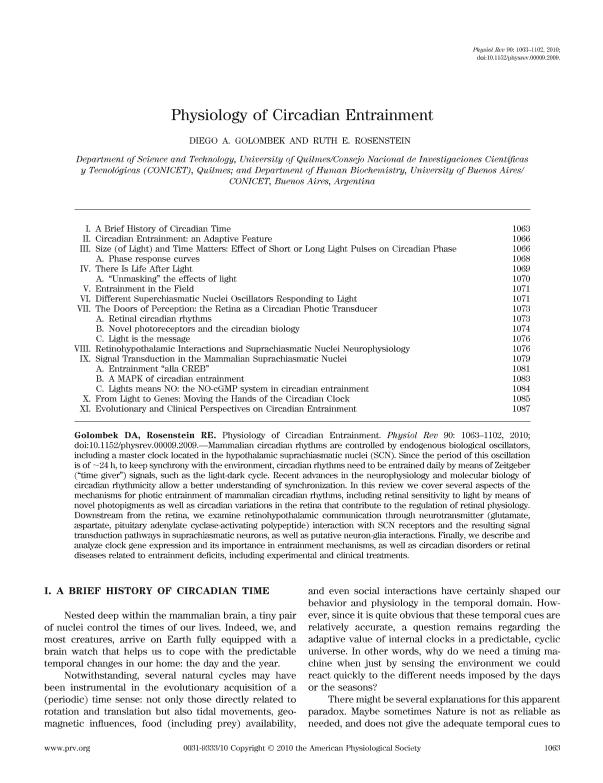Artículo
Physiology of circadian entrainment
Fecha de publicación:
07/2010
Editorial:
American Physiological Society
Revista:
Physiological Reviews
ISSN:
0031-9333
e-ISSN:
1522-1210
Idioma:
Inglés
Tipo de recurso:
Artículo publicado
Clasificación temática:
Resumen
Mammalian circadian rhythms are controlled by endogenous biological oscillators, including a master clock located in the hypothalamic suprachiasmatic nuclei (SCN). Since the period of this oscillation is of ∼24 h, to keep synchrony with the environment, circadian rhythms need to be entrained daily by means of Zeitgeber (“time giver”) signals, such as the light-dark cycle. Recent advances in the neurophysiology and molecular biology of circadian rhythmicity allow a better understanding of synchronization. In this review we cover several aspects of the mechanisms for photic entrainment of mammalian circadian rhythms, including retinal sensitivity to light by means of novel photopigments as well as circadian variations in the retina that contribute to the regulation of retinal physiology. Downstream from the retina, we examine retinohypothalamic communication through neurotransmitter (glutamate, aspartate, pituitary adenylate cyclase-activating polypeptide) interaction with SCN receptors and the resulting signal transduction pathways in suprachiasmatic neurons, as well as putative neuron-glia interactions. Finally, we describe and analyze clock gene expression and its importance in entrainment mechanisms, as well as circadian disorders or retinal diseases related to entrainment deficits, including experimental and clinical treatments.
Palabras clave:
Entrainment
,
Circadian
Archivos asociados
Licencia
Identificadores
Colecciones
Articulos(CEFYBO)
Articulos de CENTRO DE ESTUDIOS FARMACOLOGICOS Y BOTANICOS
Articulos de CENTRO DE ESTUDIOS FARMACOLOGICOS Y BOTANICOS
Articulos(SEDE CENTRAL)
Articulos de SEDE CENTRAL
Articulos de SEDE CENTRAL
Citación
Golombek, Diego Andres; Rosenstein, Ruth Estela; Physiology of circadian entrainment; American Physiological Society; Physiological Reviews; 90; 3; 7-2010; 1063-1102
Compartir
Altmétricas




